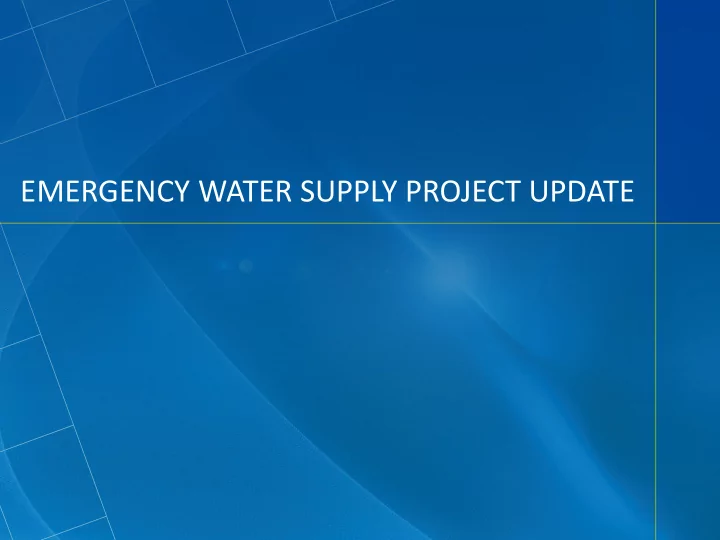

EMERGENCY WATER SUPPLY PROJECT UPDATE
Agenda • Water Treatment Plant – What is the water source – How is it treated – How is the drinking water recovered • Disposal of Brine – Evaporation/Brine Pond – Stormwater Outfall • Ensuring Drinking Water is Safe – Tracer study – Long-term monitoring
Introductions • Project Manager – Sava Nedic, PE • WTP Engineer – Greg Wetterau, PE • Hydrogeologist – Mike Smith, PG • Construction Manager – Randy Redmann • Principal-in-Charge – Mari Garza-Bird
How much water will be produced? • 300 gpm of drinking water to CCSD customers • 250 acre-feet of drinking water during the 6 month drought season
What Happens to Our Water Now? • 0.5 mgd wastewater treated at WWTP • Treated water sent to percolation ponds near San Simeon State Park • All water, including basin underflow, ultimately ends up in ocean (>45 acre-feet/mo) • Emergency project will recover this water To Ocean
What is Groundwater Replenishment? 55 gpm back to perc pond 350 gpm 690 gpm 100 gpm to lagoons 300 gpm to customer 185 gpm to 9P7
Advanced Water Treatment • Will be located east of San Simeon State Park next to percolation ponds • Treatment includes 3 primary barriers
Barrier #1: Membrane Filtration • Hollow fiber membranes remove virtually all: – Suspended solids – Turbidity – Protozoa and bacteria • Does not fully remove viruses or dissolved contaminants • Used commonly for drinking water plants
Membrane Filtration Suspended solids Dissolved salts Colloids Viruses Bacteria Parasites Org. macro. molecules 100 m m 0.0001 0.001 0.01 0.1 1 10 polio smallest Crypto- hair virus micro- sporidium organism Reverse Osmosis Ultrafiltration Sand filtration Microfiltration Nanofiltration Typical Range for Municipal Systems
Membrane Filtration • Membranes built as hollow fibers, that look like tiny straws • Water pushed through fiber walls • Tens of thousands of fibers combined into membrane module
Barrier #2: Reverse Osmosis • Spiral wound RO membranes remove: – Viruses – Dissolved salts – Dissolved organics – Pharmaceuticals and personal care products • Used commonly for treating seawater and brackish groundwater and at bottled water facilities
Reverse Osmosis • Pores in membrane too small to be measured, can remove particles as small as 0.1 nm • Removes virtually all dissolved material except: – Dissolved gases (O 2 , CO 2 , Cl 2 ) – Some small organic compounds
Barrier #3: Advanced Oxidation • Concentrated UV light and hydrogen peroxide remove any organic compounds • Additional barrier for pathogens • Operates at around 10 times higher intensity than typical UV treatment at drinking water plants
Brine Disposal Options 1. Evaporation Pond 2. Stormwater Outfall
Brine Disposal Option #1: Evaporation Pond • Evaporation blowers will only operate during the day • Sound proofing will be provided for the blowers
Evaporation Pond
9P7
9p7
Tracer Test • Pump SS1 and SS2 at a total of 454 gpm • Inject at RIW-1 with addition of tracer • Addition of tracer Bromide Salt at 10 ppm • Cease addition of tracer after 30 days • Total duration of test 67 days • At end of test wells SS1 and SS2 continue producing at 454 gpm • Gradient control pumping and discharge to lagoon not necessary during injection period
Tracer Migration Color fill area shows areas where tracer concentration is greater than 5 percent of the injected concentration
Tracer Extent Color fill area shows areas where tracer concentration is greater than 5 percent of the injected concentration
Tracer Extent Color fill area shows areas where tracer concentration is greater than 5 percent of the injected concentration
Tracer Extent – Tracer Feed Stopped Color fill area shows areas where tracer concentration is greater than 5 percent of the injected concentration
Tracer Extent Color fill area shows areas where tracer concentration is greater than 5 percent of the injected concentration
Tracer Extent Color fill area shows areas where tracer concentration is greater than 5 percent of the injected concentration
Tracer Extent Color fill area shows areas where tracer concentration is greater than 5 percent of the injected concentration
Tracer Extent – RIW-1 Injection Stopped Color fill area shows areas where tracer concentration is greater than 5 percent of the injected concentration
Tracer Extent Color fill area shows areas where tracer concentration is greater than 5 percent of the injected concentration
Tracer Extent Color fill area shows areas where tracer concentration is greater than 5 percent of the injected concentration
Tracer Extent Color fill area shows areas where tracer concentration is greater than 5 percent of the injected concentration
Tracer Extent Color fill area shows areas where tracer concentration is greater than 5 percent of the injected concentration
Tracer Extent Color fill area shows areas where tracer concentration is greater than 5 percent of the injected concentration
Tracer Extent Color fill area shows areas where tracer concentration is greater than 5 percent of the injected concentration
Tracer Extent Color fill area shows areas where tracer concentration is greater than 5 percent of the injected concentration
Tracer Extent Color fill area shows areas where tracer concentration is greater than 5 percent of the injected concentration
QUESTIONS
Recommend
More recommend